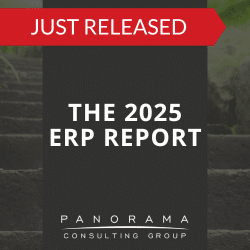Choosing the right customer relationship management (CRM) system is crucial for any business aiming to improve customer interactions, streamline operations, and boost sales. However, the plethora of CRM options available can make this decision daunting.
Today, we’re guiding you through the process of selecting a CRM system so you can sort through the options with finesse.
Expert Tips on How to Select a CRM System
Selecting a CRM system requires a focus on your business needs and goals. Here are some best practices that our ERP selection consultants use with companies across industries:
1. Define Your Business Objectives
Before diving into the selection process, clearly define what you aim to achieve with a CRM system. Are you looking to improve customer service? Increase sales? Streamline marketing efforts?
Different departments within your organization will have varying needs and expectations, so it’s important to get everyone on the same page. Setting key performance indicators (KPIs) ensures all stakeholders know what features and functionality to prioritize.
Without clear objectives, you risk implementing a CRM that doesn’t fully support your business goals.
2025 Clash of the Titans
SAP, Oracle, Microsoft, and Infor each have a variety of systems that can support data-driven decision-making. We surveyed customers of these four vendors to find out what their selection and implementation process was like.
2. Assess Your Current Processes
Evaluate your existing customer management processes to identify gaps and inefficiencies. This assessment will help you determine your business requirements.
Understanding your current state helps in identifying pain points and areas where a CRM can bring improvements.
For instance, if a company is struggling with inefficient sales processes because different departments maintain separate customer data, the company may want to select a CRM that centralizes data storage and provides real-time insights.
3. Involve Key Stakeholders
During the selection process, you should engage stakeholders from various departments—such as sales, marketing, and customer service. Their input can help you understand the practical needs and challenges of different teams.
Our ERP software consultants have found that when companies involve employees in requirements gathering sessions, the company typically experiences high user adoption at go live. End-users feel like they’re part of the team that’s “making it happen,” and they’re eager to use new software that addresses their pain points.
4. Consider Integration Capabilities
A CRM system should seamlessly integrate with your existing systems, such as ERP systems, email platforms, and eCommerce systems.
Integration ensures smooth data flow and enables sales teams to access real-time customer insights.
For example, a company might have three disparate business applications, two of which are legacy. The company struggles with data silos and misses opportunities for leveraging comprehensive customer insights. Implementing a modern ERP system could allow the business to replace all of these systems with a single integrated platform.
(Learn about the different types of legacy systems.)
5. Evaluate User-Friendliness
The success of a CRM implementation largely depends on user adoption. Our ERP implementation consultants always tell clients that achieving project goals is only possible when end-users consistently and effectively use the new software.
While effective change management is one piece of user adoption, user-friendliness is the other piece. Look for a CRM system that is intuitive and easy to use, while prioritizing features like a clean user interface, customizable dashboards, and mobile accessibility.
A user-friendly CRM reduces the learning curve, increases productivity, and ensures that your team can fully utilize the system’s capabilities.
6. Plan for Scalability
Choosing a CRM system that can grow with your business is crucial for accommodating increasing data volumes and expanding user bases without compromising performance.
Consider both the short-term and long-term needs of your business when evaluating software options. Look for a scalable CRM that enables you to continually meet customer demands and maintain efficient operations as your business evolves.
Snapshot of Some Popular CRM Vendors (and ERP Vendors)
Microsoft Dynamics 365
Microsoft Dynamics 365 is a comprehensive business solution that integrates CRM and ERP capabilities. It is designed to help businesses manage their sales, customer service, and operations efficiently. Microsoft Dynamics 365 is suitable for businesses of all sizes and industries, offering flexibility and extensive integration options.
SAP CRM
SAP CRM is designed to help businesses manage customer relationships across sales, marketing, and service. The system is known for its robust integration with SAP’s ERP solutions, making it an excellent choice for businesses already using SAP systems.
Salesforce
Salesforce is a CRM platform known for its comprehensive features and robust customization options. It is suitable for businesses of all sizes, from small startups to large enterprises. Salesforce offers a wide range of tools that can be tailored to meet specific business needs, making it a highly versatile solution.
HubSpot
HubSpot is a CRM platform that offers a wide range of tools for marketing, sales, and customer service. It is particularly popular among small to mid-sized businesses. HubSpot’s intuitive design and integrated approach make it an excellent choice for companies looking to improve customer engagement without a steep learning curve.
Zoho CRM
Zoho CRM is a CRM solution that caters to businesses of all sizes. It offers a wide range of features and integrations, making it a popular choice for diverse industries. Zoho CRM’s flexibility and extensive customization options make it a strong contender for businesses looking for a tailored solution.
Exploring CRM Deployment Models: SaaS, On-Premise, and Hybrid
SaaS (Software as a Service)
SaaS CRM systems are cloud-based solutions that are hosted and maintained by the vendor. Users can access the CRM via a web browser or mobile app.
Advantages:
- Cost-Effective: SaaS software is typically offered as a subscription service, making SaaS CRMs accessible for businesses with limited budgets.
- Scalability: This software is easily scalable to accommodate growing data and user needs without significant investments in infrastructure.
- Accessibility: This software is accessible from anywhere with an internet connection, which is particularly useful for businesses with remote teams or multiple locations.
- Automatic Updates: Vendors provide regular updates and maintenance, which reduces the burden on internal IT teams and ensures that the CRM is always running the latest features and security patches.
Considerations:
- Data Security: Ensure the vendor complies with data security standards and regulations. It’s crucial to verify that the CRM provider has robust security measures in place to protect sensitive customer data.
- Dependence on Internet: Businesses need to ensure reliable internet connectivity to avoid disruptions in CRM access.
- Limited Customization: While SaaS CRMs offer many features, they might not be as flexible as on-premise solutions in terms of customization.
On-Premise CRM
On-premise CRM systems are installed and maintained on the company’s own servers. This option provides full control over the system and data. On-premise CRMs are often chosen by businesses with specific security or compliance requirements.
Advantages:
- Full Control: With complete control over data, security, and customization, businesses can configure the CRM to meet their needs and maintain complete oversight of data security.
- Integration Flexibility: On-premise software is easier to integrate with other on-premise systems. They can also be more seamlessly integrated with existing internal systems.
- Compliance: This software is suitable for industries with strict data compliance and regulatory requirements.
Considerations:
- High Initial Cost: This option requires significant upfront investment in hardware and software, which can be a barrier for small businesses with limited budgets.
- Maintenance: The company is responsible for system maintenance, updates, and security. This requires dedicated IT resources and can be time-consuming and costly.
- Limited Accessibility: This software is typically accessible only within the company’s network, so businesses may need to invest in additional solutions to enable remote access.
Hybrid CRM
Hybrid CRM systems combine elements of both SaaS and on-premise models. Data and applications can be stored both on-premise and in the cloud. This option provides flexibility for businesses that have specific needs for data storage and access.
Advantages:
- Flexibility: Hybrid software offers the flexibility to store sensitive data on-premise while leveraging the cloud for other functionalities. Businesses can choose where to store different types of data based on security and accessibility needs.
- Scalability: Businesses can scale certain aspects of the system using cloud resources. This allows businesses to manage growth more effectively without overhauling their entire CRM infrastructure.
- Cost Management: This software allows for balanced cost management by combining on-premise and cloud resources. Businesses can optimize costs by leveraging the benefits of both deployment models.
Considerations:
- Complexity: Businesses may find that it can be complex to manage and integrate both environments. Hybrid CRMs require careful planning and management to ensure seamless operation.
- Cost: Businesses may incur higher costs due to the need for both on-premise and cloud infrastructure. It’s important to consider the total cost of ownership, including hardware, software, and cloud services.
- Security: This software requires robust security measures to protect data across both environments. Ensuring consistent security policies and practices can be challenging when managing multiple deployment models.
Choosing the Right CRM Doesn’t Have to Be Painful
The technology you use to handle your sales process and your customer experience is only one part of a bigger picture. Without data integration, employee buy-in, and strategic alignment, your CRM implementation will derail your digital strategy.
Our unbiased team can help you select a CRM vendor that aligns with your overall digital strategy. Contact us below for a free consultation.













